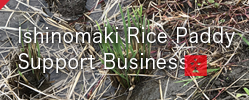A rice reaping event
For decades, I had not experienced an autumn that was so radiant and full of life. The season from spring to summer is what I like the most. I feel an increase in social activity as the season passes and expect business to progress as the temperature gradually becomes hotter. However, this autumn was distinctively different. Underneath the clear blue sky, the sweet smelling fragrance ascends from the rice fields and mountain forests, the flavor dissolved into the serene air adding a splendid taste. As I stand by the rice field, the overwhelming fragrance in the air engulfs me. Sometimes people say “mono-nari-ga-ii” (mono means crops and fruits; nari means ripening or maturing; ga-ii means “be good”; so the full sentence means “good ripening”) and I’ve come to understand the meaning of this saying for the first time.
As soon as I arrived at the rice field of Dewa Shonai Tokusan, I immediately noticed the expression of their staff were bright and cheerful. As I got out of the car and made my way there, the son of the farmer came up to greet me. We talked about a few things and I could see that he looked happy and pleased with everything. This could possibly be because of an abundant harvest.
His father, as a representative of Dewa Shonai Tokusan, started making rice since he was a teenager. After he became the representative, he continued to maintain the beautiful rice fields. When I asked the son how his father was able to consistently have a good harvest year after year, he said firstly, it was because of good soil. The second reason was his father’s special ability called “wild feeling” that gives him the sensitivity to connect with nature and with the crops. It was inspiring to see how he understood his father and his work. Someone told me that a former young employee who quit the farm came to help today. I was glad to hear that.
“We yielded good rice this year, we rarely produce poor rice”. The representative Itagaki told me as he showed the tip of an ear of rice.
For the first time, this farm carried out a “wet rice field ownership system”. This system presents the rice and the events to owners who have rented a portion of the field for a year. Owners get the rice yielded from the field and take part in the rare and exciting events. The events are hands-on and the system is called experience-based service, which includes rice planting in May and rice reaping in October. Through these events, the owners can experience wet-rice farming together with farmers and other owners. Today marks the day of the event. In the rice planting event in May, they planted rice the traditional way, manually, instead of using a planting machine. In the same manner, today they will reap rice with a sickle instead of a combine harvester and dry the rice in the sun without using the drying machine; the old way of farming. A local, up- and- coming company’s staff assist the event. They help with the preparation and paperwork for the farmer and practice doing backyard tasks. I’ve heard that there are close to 40 participants in today’s event. I hope it’ll be a bustling event like a festival.
At half past 10, the representative Mr. Itagaki gave an orientation with a practical demonstration for participants (it was a very short lecture), then 40 participants of all ages and both sexes entered into the rice field. There was a deep muddy division in the field and some people got stuck in the deep mud as soon as they entered the field. Some lost their rubber boots in the mud, some slipped and fell in the mud. It caused a bit of a panic. Reaping rice makes them feel good and they enthusiastically cut the plants but the next process is quite difficult for beginners.
They must gather a handful of rice plant, cut them with a sickle and tie them up with stems of the rice plant as a rope. They need to learn the technique to tie it quickly and tightly. After binding the rice plants into bundles, they dry them with an old method called “kui-gake” ( “kui” is stake and “gake” is to stab and pile).
Along the ridge between rice fields, there are strong wooden stakes about the size/diameter of an adult human arm and about 2 meters high. These are lined in a row about 3 meters apart.
They bind the first bundle tightly on the stake making this the base, securely stacking 2 bundles with the stake in between them, followed by the next bundle on top of that. When this process is done, the kui-gake figure of the stake resembles a big pine cone.
Then the rice bundles are dried under the sun for 3 weeks so that the water is completely removed from the rice. When I asked the representative what happens when it rains, he said once the rice is sun dried, even if it gets wet in the rain, it will dry up quickly. His answer didn’t seem to make any sense but I did not press further. Anyway, I figured that once farmers start to dry rice in the open air, under the sun, they do not move them indoors even if it rains. If this is what they have been doing for generations, I’ll assent.
Then after several days, the farmers stack the bundles again, this time in the opposite direction, to ensure that these are exposed to the sunlight as well and dry out completely.
Lunch was “imo-ni” (“Imo” is potato and “ni” means to boil in a pot) boiled potatoes (a kind of taro root) in a large pot with miso, a special local dish.
Imo-ni was served as the main dish with a bowl of rice. This dish was made in a large stainless steel pot that can contain nearly 40 liters seasoned with miso, a secret recipe. The miso is fermented for three years to bring out its unique taste, color and flavor. A 5.4 liter of raw rice is boiled for staple food. To boil such a large amount of taro and cook the rice, they would need a bigger burner than the one used at home so a local restaurant boiled them in their kitchen for the lunch. This way, it is possible to procure complementary resources immediately without trouble, less paperwork and procedures, just a simple “please” and “sure”. It always impresses me. Such as the grill made from oil drum, and the special wooden tool for printing patterns on the surface of the field, Jane Jacobs would admire them as a model case of improvisation.
(In this case if you take ‘improvise’ as ‘to invent music, the word in a play, a statement, while you are playing or speaking, instead of planning in advance’, it is referred in Japanese-English dictionary, you cannot understand the real meaning. You should take the word as ‘to make or do something using whatever is available, usually because you do not have what you really need, and using your originality and ingenuity’)
I went to the kitchen of the restaurant, about 10 minutes away from the rice field to help. Though I was an outsider and a stranger in the kitchen, the staff were very kind and treated me as though they have known me for 100 years. As I went around the kitchen, they explained about the ingredients such as shrimp, spring onions and so on as well as the origin of the taste and flavors. They even gave me sashimi to taste. The whole time, I felt how warm hearted and kind the people from Shonai were.
After lunch, the participants went back to reap rice in the district where they hadn’t worked on. They did the “Kui-gake” and finished their task for the day.
They breathed fresh air, played in the mud with their family, released their physical tension through heavy labor, ate delicious food until they were full. I guess the owners were certainly satisfied with the event.
After that, they went to the hot spring operated by the village, went to their favorite places and went home.
It was a fine day and all of them, including myself felt the full satisfaction of the autumn harvest through the five senses.
A festival and the usual routine
After the rice reaping event, in the same way as the preparation, the clean up after the event was carried out in silence by the staff of the local company as mentioned before, without the knowledge of the guests/owners.
This is a ceremony that ends the festival and the daily routine resumes.
From here on, farmers will restart to reap rice as their routine work.
The rice field that the owners are renting is less than 1,000 sq. m. Compared to this, the farm cultivates more than 130,000 sq. m. That means that Dewa Shonai Tokusan should reap rice from an area 130 times larger than the owners.
Moreover, the 130,000 sq. m. area consists of more than 90 small fields which are scattered throughout the city of Tsuruoka. The farthest field is about 20 km. away from the farmer’s house. And yet they must be on time for reaping. Therefore the father who is about 88 years old and the son of the representative go to work on a tractor to the fields in different locations.
A busy period.
Though it is a busy period, Dewa Shonai Tokusan begins this activity, because they would like the residents in cities or local young people to enjoy farming even briefly.
A story about an autumn memory 40 years ago
I went for an errand in a car driven by a woman who was a helper for Dewa Shonai Tokusan, and I heard this story from her.
She was also a daughter of a farmer at that time.
When she was in elementary school, during the harvest periods, she often found several strange old men and women in her house, who came and stayed to help harvest rice. She said that as a child, she felt a little scared of strange old people staying in her house. Housewives were very busy providing board meals for the helpers. The meals were so gorgeous like the New Year dishes. In those days, most people didn’t have cars so the helpers traveled a long way on foot. They couldn’t return home every day so they stayed at the farmer’s house during the harvest period. These days, farmers have tractors and thanks to these powerful machines, most farmhouses do not need the help of other people.
However, I remember a certain researcher whose study focused on the city. High spec agricultural machines resulted in surplus labor force in a rural community but the city didn’t create enough employment opportunities for them. The city grew bigger absorbing the lowest possible number of employees it needed; it began to control the nation for its own motive, excluding rural communities. That was the point of the researcher.
Of course, there is no specific cure for regional/local revitalization. But if the local sector has an ability or function which replaces imported things with things that the locals improvise*, you can see hope, the researcher wrote in her book. Fortunately, I think Shonai is the town where we can find the seeds of hope.
The rice reaping event is over.
After three weeks of drying rice under the sun in the open air, the fresh rice filled with the owner’s expectation are finally ready to be sent to the participants. In the meantime, the farmer continues harvesting and spending their time working. Autumn deepens in Shonai.


















